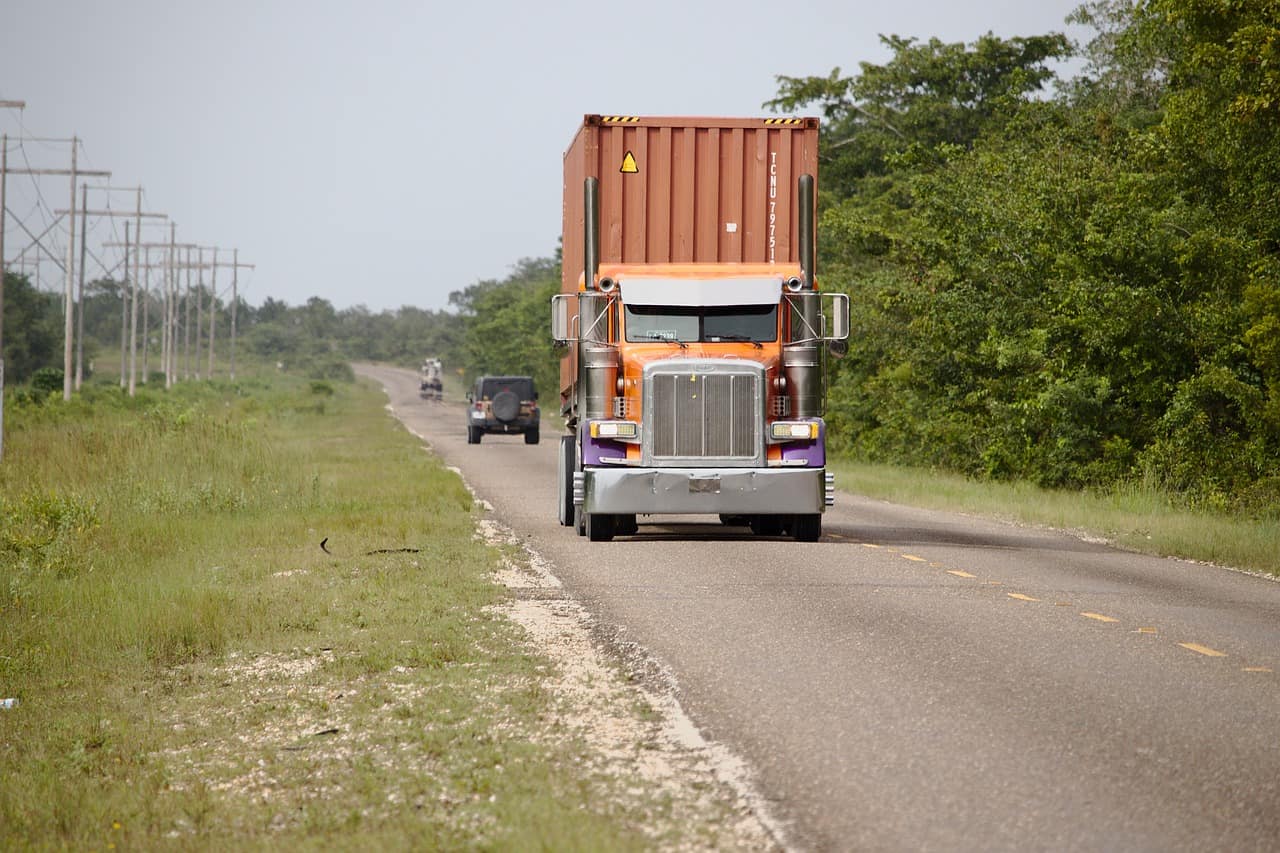Have you found yourself asking, “What is flatbed trucking?” Are you already familiar with curtainside trailers and other types of trailers?
Maybe you are but you just want to learn more about flat beds in general. Or are you an owner-operator who hauls other types of loads yet you find yourself considering the prospect of making the switch to flatbed trucking?
No matter where you stand on the matter, this article will definitively answer the question, “What is flatbed trucking?” It will also cover important topics like flatbed pay, key driver considerations and more so that you can better understand flatbed trucking as a whole.
How Does Flatbed Trucking Work?
Flatbed trucking is a way to transport oversized or unusually shaped items and containers. Flatbed trailers have no roofs or walls. Therefore, drivers need to use tarps, straps and other equipment to secure their loads.
What Is a Flat Bed in Trucking?
A flat bed in commercial trucking is a trailer that lacks a roof or walls. The size of a flatbed trailer is usually about 48 feet long and 8.5 feet wide.
What Does a Flatbed Truck Driver Do?
A flatbed truck driver is responsible for securing cargo onto vehicles before driving towards the next destination. They accomplish this using tarps, straps and other equipment.
Flatbed truckers are responsible for the removal of this equipment when they arrive at their destinations. Typically, flatbed truckers must adhere to more stringent regulations than other drivers. This is because they frequently haul heavy, cumbersome and oversized loads.
What Is the Max Weight On a Flatbed Truck?
Most flatbed trucks are capable of hauling between 40,000 and 46,000 pounds of materials. The exact carrying capacity varies depending on the type of flatbed involved.
What Are Common Uses of Flatbed Trucking?
Flatbeds are used to haul many different items. A few prime examples include the following:
- Construction equipment
- Military equipment
- Portables or mobile homes
- Steel beams
- Objects too large to be stored in an enclosed trailer
These are just a handful of examples. Flatbeds can accommodate virtually any materials that fall within the trailer’s weight and length limitations.
What Are the Rates for Flatbed Trucking?
Flatbed trucking rates depend on a few factors, including region, skill requirements and the items being hauled. The national average rate per mile for flatbed trucking is roughly $3.07 in most cases. As a result of this competitive pay, flatbed drivers make approximately $61,000 annually, but top earners bring in more than $90,000 per year.
What Flatbed Truck Drivers Need to Consider
Driving a flatbed truck can be far more dangerous than operating the average box truck. Some of the hazardous aspects of flatbed trucking include loading freight, securing loads and tarping the goods.
Loading Freight
Freight can be loaded onto a flatbed either manually or with the assistance of cranes and other machinery. The location and the type of equipment will both collectively dictate how the materials are loaded.
Securing the Load
There are strict regulations as to how a load should be secured on a flatbed truck. Those regulations detail which types of tie-downs drivers must use. They also outline procedures for double-checking that loads are actually secure.
Tarping the Goods
Properly tarping cargo is an acquired skill, but it’s an important one to hone so that drivers can provide an added layer of security to the shipments they transport when tarping is done correctly. Tarps that haven’t been properly secured could detach from the loads while on the road, which can create a hazardous situation for the trucker as well as other drivers around them.
How To Maneuver a Flatbed Truck
While one of the benefits of driving a flatbed truck is the ability to take on loads that are larger or unusually shaped, it also requires a high level of skill to drive a flatbed while transporting those types of cargo.
This is why companies tend to pay flatbed truckers a higher per-load rate. The opportunity to earn better pay is what makes flatbed trucking appealing to many drivers.
Types of Flatbed Trailers
There are a variety of different flatbed trailers in production. Some of the most commonly used flatbed trailers include standard, drop decks, double-drops, stretch, extendable, curtainside, lowboys and covered wagons.
Standard
The standard flatbed is typically used to haul products such as machinery or heavy metals. These trailers feature a 48-foot flatbed without a roof or walls.
Drop Deck
Drop deck flatbed trailers are also known as step-deck or single-drop flatbeds. They are designed with a bed that is closer to the ground than standard flatbeds, allowing for an additional two feet of overhead clearance.
Double-Drop
Double-drop flatbed trailers have a distinctive drop in the center, which is lower than both ends of the trailer. This design allows drivers to transport taller freight. Double-drop flatbed trailers are often used to carry freight that requires a crane to load and unload as well.
Stretch or Extendable
Stretch flatbed trailers are ideal for loads that are too long for standard 48-foot flatbeds. However, drivers must obtain special permits to haul loads using stretch or extendable trailers.
Curtainside
Curtainside flatbed trailers are ideal for ease of loading and unloading. They’re fitted with stakes and panels to enclose cargo on all but one side.
Lowboy
Lowboys are ideal for tall shipments that may be too tough to handle for a step deck. Lowboy trailers lie 18 feet off the ground, making them capable of accommodating freight up to 11 feet 6 inches tall.
Covered Wagon
Covered wagon flatbed trailers are also known as side-kit flatbeds. They contain a tarp with stakes and panels to create an additional layer of shelter around cargo. These are ideal for shipments that are sensitive to the natural elements.
Advantages of Flatbed Trucking
The benefits of flatbed trailers include the following:
- Less maintenance
- More time on the road
- Better pay rates
- Less gas spent on trips
Many drivers prefer flatbed trucking because they can only accommodate a single load at a time. As such, they do not have to make multiple stops once their trucks have been loaded. Instead, they can pick up freight, take it to its destination and book their next load.
Disadvantages of Flatbed Trucking
Even though the benefits of flatbed trucking are clear, there are disadvantages associated with it, too. Some of those may include the following:
- More regulations to adhere to
- More driving hazards than usual
- More time spent loading and unloading
- Natural elements that make the job more difficult
Despite these factors, flatbed trucking remains both in demand and popular within the trucking community, especially among owner-operators.
Flatbed vs. Dry Van
Unlike flatbed trucking, dry van trucking entails the use of a vehicle or a trailer with an enclosed cargo area. Dry van trucks provide drivers with protection from the elements, which is hard to come by with flatbed trucking, though the trucks don’t offer the same flexibility as flatbeds.
Along with flexibility, flatbed shipping holds another advantage over dry van shipping: There are multiple ways to load freight onto a flatbed. Dry van trailers are typically restricted to loading cargo from the rear to the front, while flatbed trailers also allow for loading from the sides or top.
Should I Become a Flatbed Trucker?
Flatbed trucking is an appealing career path, especially if you already have your CDL and you are active in the trucking industry. Making the switch to flatbeds can help you earn more, spend less time loading cargo and simplify delivery processes overall.
However, operating a flatbed is not right for everyone. You should carefully weigh the pros and cons of each option before you make your final decision.
If you enjoyed this article from the FreightWaves Ratings team, be sure to explore other resources. The experts tackle a multitude of trucking and logistics related topics, such as how much used semitrucks cost and much more. There are also reviews of vital equipment, like electronic logging devices, GPS hardware and dashcams.
FAQ
Generally speaking, yes, companies tend to pay more for flatbed loads. This is because loading and unloading materials hauled on a flatbed trailer can be quite labor-intensive for the driver.
The flatbed industry experiences seasonal fluctuations in demand, much like other trucking sectors. Additionally, demand for flatbed shipping tends to fluctuate with the demand for construction services.
Driver pay will vary based on several factors, including whether you work for a company or you are an owner-operator. Pay also varies by region. With that in mind, you should check load boards or connect with local businesses that employ flatbed truckers to learn more.




